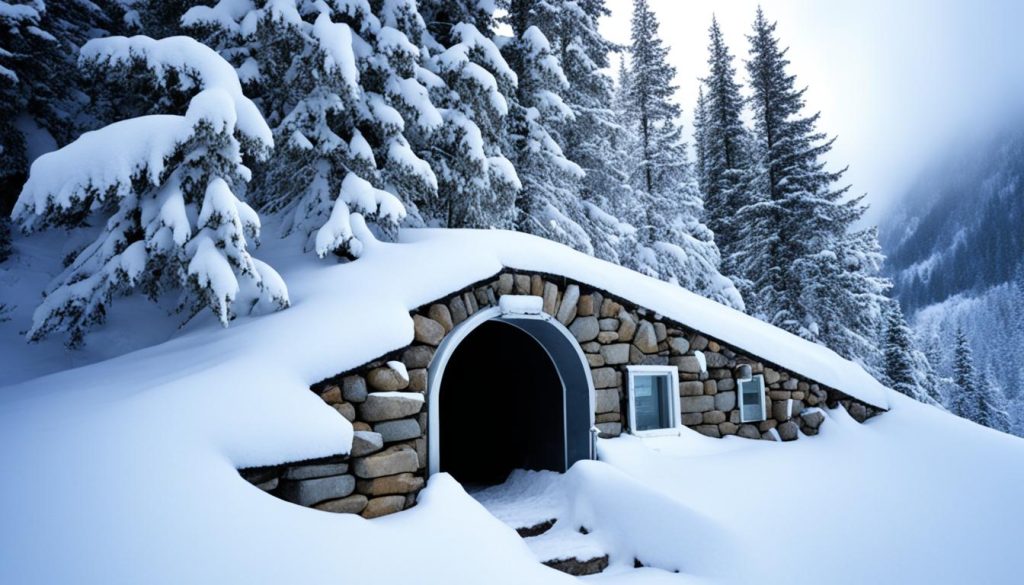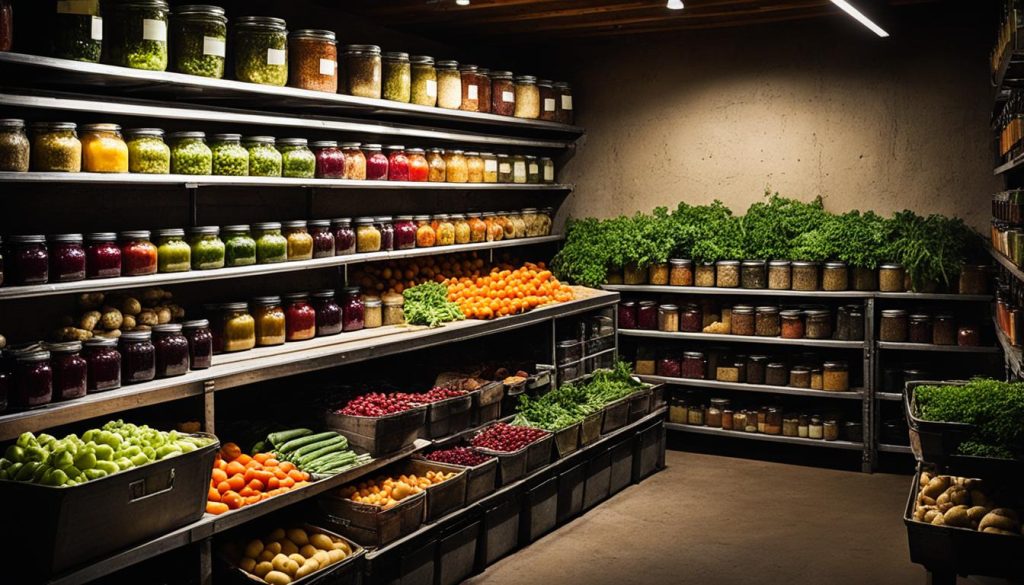Did you know that the average American household wastes about 30-40% of the food they purchase each year? That’s an alarming statistic that highlights the need for effective food storage solutions. One method that has stood the test of time is building a root cellar for storage. Not only does it provide a sustainable way to store fruits, vegetables, and more, but it also extends the lifespan of your produce, reducing food waste and saving you money in the long run.
Key Takeaways:
- Building a root cellar allows for underground storage, providing optimal temperature control and humidity management.
- A well-designed root cellar can extend the longevity of seasonal produce, providing access to fresh food long after harvest time.
- There are multiple types of root cellars to choose from, depending on available space and personal preferences.
- Consider the climate in your area when planning a root cellar, as alternative food preservation methods may be necessary in warm or dry climates.
- Proper storage techniques, such as selecting the right crops, examining produce for damage, and avoiding freezing, can maximize the effectiveness of your root cellar.
What Is a Root Cellar?
A root cellar is a structure used to store food, such as fruits, vegetables, and nuts. Traditionally, root cellars were used to store root vegetables like potatoes, carrots, and beets. They were essential for storing food before the advent of electricity and refrigeration. Root cellars do not require electricity and are usually buried underground to maintain cooler temperatures in the summer and prevent freezing in the winter. Storing vegetables in a root cellar can help to keep them fresh for weeks or even months longer than storing them on the kitchen counter.
Root cellars provide an ideal environment for food preservation. The cool and dark conditions help to slow down the ripening process and inhibit the growth of bacteria and fungi that cause decay. The stable temperature and high humidity levels in a root cellar create an optimal environment for storing fresh produce. Fruits, vegetables, and nuts will stay crisp and flavorful for extended periods of time when stored in a root cellar.
“Storing vegetables in a root cellar can help to keep them fresh for weeks or even months longer than storing them on the kitchen counter.”
In a root cellar, fruits and vegetables are able to retain their nutrients and flavors while minimizing waste. This makes root cellars an excellent choice for anyone interested in sustainable living or those seeking to reduce their reliance on commercial food sources. By storing fresh produce in a root cellar, individuals can stockpile food, ensuring they have access to nutritious meals throughout the year, regardless of seasonal availability.
Advantages of Using a Root Cellar for Food Preservation
Using a root cellar for food preservation offers several advantages:
- Extended Shelf Life: Fruits, vegetables, and nuts stored in a root cellar can remain fresh for longer periods compared to conventional storage methods. This allows for a steady supply of fresh produce throughout the year.
- Economical: Building and maintaining a root cellar is cost-effective, as it reduces the need for refrigeration and prolongs the lifespan of fresh produce. It can also save money by enabling bulk purchases and reducing food waste.
- Nutrient Retention: The controlled storage conditions in a root cellar help to preserve the nutritional value of fruits, vegetables, and nuts.
- Self-Sufficiency: Having a root cellar allows individuals to become self-sufficient by growing and storing their own food, even in areas with limited access to grocery stores or during times of crisis.
Whether you want to store your home-grown harvest or take advantage of seasonal produce, a root cellar is a valuable addition to any homestead or garden. It provides a natural and sustainable method of food preservation, enabling you to enjoy fresh and nutritious produce throughout the year.
Types of Root Cellars
When it comes to building a root cellar, there are different types to choose from depending on individual needs and preferences. Each type of root cellar has its own advantages and considerations, making it important to select the right one for your specific storage requirements.
Barrel Root Cellar
A barrel root cellar is a small-scale option suitable for storing small amounts of produce. As the name suggests, this type of root cellar utilizes a barrel as the main storage container. It is a budget-friendly choice for those with a limited amount of fruits, vegetables, or nuts to store.
Traditional Root Cellar
The traditional root cellar, also known as the classic or conventional root cellar, is accessed from outside the home. It is typically an underground structure with a door that leads to the storage area. This type of root cellar provides a larger storage capacity, making it ideal for homesteaders and those with larger quantities of produce to store.
Hill Root Cellar
A hill root cellar is built into the side of a hill, taking advantage of the natural insulation provided by the earth. This type of root cellar offers excellent temperature and humidity control, making it an efficient choice for long-term food storage. It is particularly suitable for areas with rolling landscapes or hillsides.
Under-Structure Root Cellar
An under-structure root cellar is integrated with a house or shed, with the storage area located below the living space. This type of root cellar allows for easy access to stored produce without the need to venture outside. It is a convenient option for those who want direct access to their food storage.
Above-Ground Root Cellar
An above-ground root cellar is built at ground level and surrounded by soil or rocks. This type of root cellar provides insulation and maintains a relatively stable temperature, similar to an underground root cellar. It is a versatile option that can be customized to suit the specific needs and aesthetics of the property.
When deciding on a root cellar type, it is crucial to consider factors such as storage capacity, accessibility, insulation, and the prevailing climate in your area. By selecting the right type of root cellar, you can ensure optimal conditions for preserving your fruits, vegetables, and nuts for extended periods.
Root Cellars in Different Climates
When it comes to designing root cellars, maintaining specific temperature and humidity levels is crucial for optimal food preservation. While root cellars are known to work well in cooler climates, they may not be as effective in warm or dry southern climates. In such regions, alternative methods like canning, dehydrating, or fermenting can be more suitable for long-term food preservation.
Warm climates pose challenges for root cellars due to the higher humidity levels and temperatures. The ideal humidity level for root cellars ranges between 85% and 95%, as this helps prevent the produce from drying out or becoming too moist. In warm climates, it can be challenging to maintain this specific humidity range, which may negatively impact the longevity of stored fruits and vegetables.
To overcome the limitations of root cellars in warm climates, alternative food preservation methods can be employed. Canning is a popular option that involves sealing fruits and vegetables in jars after they have been cooked or processed. This method not only preserves the freshness of the produce but also extends their shelf life. Dehydrating is another effective method, especially for fruits and vegetables that are naturally low in moisture. By removing most of the moisture content, dehydrated foods can be stored for long periods without the need for refrigeration.
In warm climates, alternative methods such as canning, dehydrating, or fermenting may be more suitable for preserving food.
Fermenting is a traditional preservation method that involves converting carbohydrates in foods into acids or alcohol through the action of microorganisms. Fermented foods have a long shelf life and provide additional health benefits, such as improved digestion and increased nutrient availability. Fermenting is a versatile preservation method that can be applied to various types of fruits and vegetables, making it an excellent option for warm climates.
When planning a root cellar, it is important to consider the climate and the specific needs of the crops that will be stored. Understanding the temperature and humidity requirements of different fruits and vegetables is crucial for ensuring their long-term preservation. By combining the use of root cellars with alternative preservation methods like canning, dehydrating, and fermenting, individuals can effectively store produce in warm climates and enjoy the benefits of fresh food throughout the year.
| Climate | Recommended Preservation Methods |
|---|---|
| Warm and Humid | Canning, Dehydrating, Fermenting |
| Warm and Dry | Canning, Dehydrating, Fermenting |
| Cool and Humid | Root Cellars, Canning, Fermenting |
| Cool and Dry | Root Cellars, Canning, Dehydrating |
How to Store Fruits and Vegetables in a Cellar
Storing fruits and vegetables in a root cellar is a great way to preserve their freshness and extend their lifespan. Here are some tips on how to store produce in your cellar:
- Choose the right crops: Select late-maturing crops and storage crops that have a longer shelf life. These varieties are more likely to retain their flavor and quality throughout the winter months.
- Avoid washing: It’s best not to wash the produce before storing. Washing can introduce excess moisture, which can lead to rot. If washing is necessary, make sure to dry the vegetables thoroughly before placing them in the cellar.
- Curing vegetables: Certain vegetables, such as onions and garlic, benefit from a curing process. This involves allowing them to dry in a warm, well-ventilated area before storing. Curing helps to toughen the outer layers and extend their shelf life.
- Examine produce: Before storing, carefully examine the produce for any signs of damage or spoilage. Remove any damaged items as they can quickly spoil the rest of the produce. Only store healthy, unblemished fruits and vegetables.
- Avoid freezing: Freezing produce is not recommended for cellar storage. Freezing can affect the texture and overall quality of fruits and vegetables, leading to loss of flavor and increased likelihood of rot.
By following these guidelines, you can ensure that your stored fruits and vegetables stay fresh and delicious throughout the winter months. Proper storage techniques in a root cellar will help you enjoy the bounty of your harvest for an extended period of time.
Sample Root Cellar Storage Chart
| Produce | Storage Temperature | Storage Humidity | Storage Duration |
|---|---|---|---|
| Potatoes | 32-40°F (0-4°C) | 90-95% | 3-5 months |
| Carrots | 32-40°F (0-4°C) | 90-95% | 4-6 months |
| Apples | 32-40°F (0-4°C) | 90-95% | 2-6 months |
| Onions | 32-40°F (0-4°C) | 65-75% | 4-6 months |
| Winter Squash | 50-55°F (10-13°C) | 50-75% | 2-6 months |
Here are some additional tips for successful root cellar storage:
- Keep the cellar well-ventilated to prevent the accumulation of moisture and the growth of mold.
- Monitor the temperature and humidity levels regularly to ensure they are within the recommended ranges for the specific crops you are storing.
- Use shelves or storage bins to keep the produce organized and easily accessible.
- Rotate the stored produce periodically, using the oldest items first to prevent spoilage.
With proper storage techniques and careful attention to temperature and humidity levels, your root cellar can be a valuable asset for preserving the goodness of your harvest and enjoying fresh, homegrown produce throughout the year.
Where to Build a Root Cellar
A root cellar can be built in various locations depending on individual circumstances. It is possible to build a root cellar in the basement of a home or outside the house. If building a root cellar in the basement, it is important to consider proper ventilation and insulation to maintain the desired temperature and humidity levels. Retrofitting an existing basement corner can be a cost-effective option.
Another option is to build a root cellar underneath an exterior porch, which can provide easy access from inside the home. For new home construction, it is possible to incorporate a root cellar into the design and construction process. The choice of location will depend on factors such as available space and personal preferences.
If you need guidance on building a root cellar or want to learn more about different types of root cellars, you can visit this resource for more information.
Step-By-Step Guide to Building a Root Cellar
Building a root cellar is a rewarding project that requires careful planning and attention to detail. With the help of a step-by-step guide, you can ensure a successful construction process and create a functional space for long-term food storage. Here’s how to build a root cellar:
1. Determine the Location
The first step in building a root cellar is to determine the best location for it. Ideally, choose a spot that is easily accessible and offers good drainage. Consider whether you want to build an above-ground or underground root cellar, as this will impact the design and construction process.
2. Plan the Design
Next, plan the design of your root cellar. Consider factors such as ventilation, insulation, and humidity control. Adequate ventilation is crucial to prevent spoilage and mold growth, so ensure that your design includes vents or windows for airflow. An earth-sheltered design can help maintain cooler temperatures, while insulation will help regulate temperature fluctuations and conserve energy.
3. Gather Materials
Gather all the necessary materials for your root cellar construction. This may include concrete, lumber, insulation materials, ventilation components, and shelving or storage bins. Choose materials that are rot-resistant and suitable for the desired purpose of your root cellar.
4. Excavate and Build
Once you have the materials ready, start by excavating the area where the root cellar will be located. Follow the dimensions and layout specified in your design plan. Begin building the walls using the selected materials, ensuring they are solid and well-insulated. Install the ventilation system and any necessary electrical wiring according to safety regulations.
5. Consider Humidity and Darkness
Humidity and darkness are essential factors for successful root cellar storage. Install a hygrometer to monitor humidity levels, and consider adding a humidifier or dehumidifier to maintain optimal conditions. Ensure your root cellar is completely dark to prevent sprouting and spoilage of your stored produce.
6. Install Shelving and Storage Bins
Organize your root cellar by installing shelves or storage bins. This will help keep your produce organized, accessible, and properly ventilated. Consider using wire racks or open shelves to promote airflow and prevent moisture buildup.
7. Test and Monitor
Before storing your produce, test your root cellar for temperature and humidity levels. Make any necessary adjustments to ensure optimal conditions. Regularly monitor the temperature, humidity, and overall condition of your stored food to ensure it remains in good quality.
8. Enjoy Your Homemade Root Cellar
Once your root cellar is complete and fully functional, you can start enjoying the benefits of long-term food storage. Preserve your harvest, seasonal crops, and other perishable items in your homemade root cellar to extend their shelf life and reduce waste.
Building a root cellar is a rewarding endeavor that offers a sustainable solution for food storage. By following a step-by-step guide and considering important factors such as ventilation, earth-sheltering, humidity, darkness, shelving, and storage bins, you can create an efficient and effective root cellar to meet your needs. Start building and enjoy the benefits of a well-preserved harvest!
Conclusion
Building a root cellar is a practical and sustainable solution for those who value self-sufficiency and want to stockpile food for the long term. Root cellar construction enables the preservation of large quantities of produce, reducing the reliance on refrigeration and electricity. This not only promotes sustainable living but also ensures food security even during unforeseen circumstances.
While the cost of building a root cellar can vary, there are affordable options available that utilize recycled or repurposed materials. By considering factors such as climate and location, individuals can tailor their root cellar design to best suit their needs. Proper storage techniques, such as maintaining the right temperature and humidity levels, are essential for maximizing the longevity of stored items.
For those seeking guidance and inspiration, there are various root cellar books available that provide detailed instructions and tips on construction. These resources can assist in the planning and building process, ensuring a successful and functional root cellar. Overall, incorporating a root cellar into a homestead or garden is a valuable investment that supports sustainable living and offers a reliable method of food preservation.


